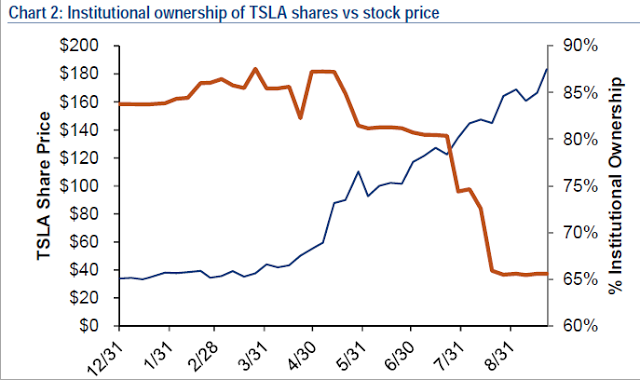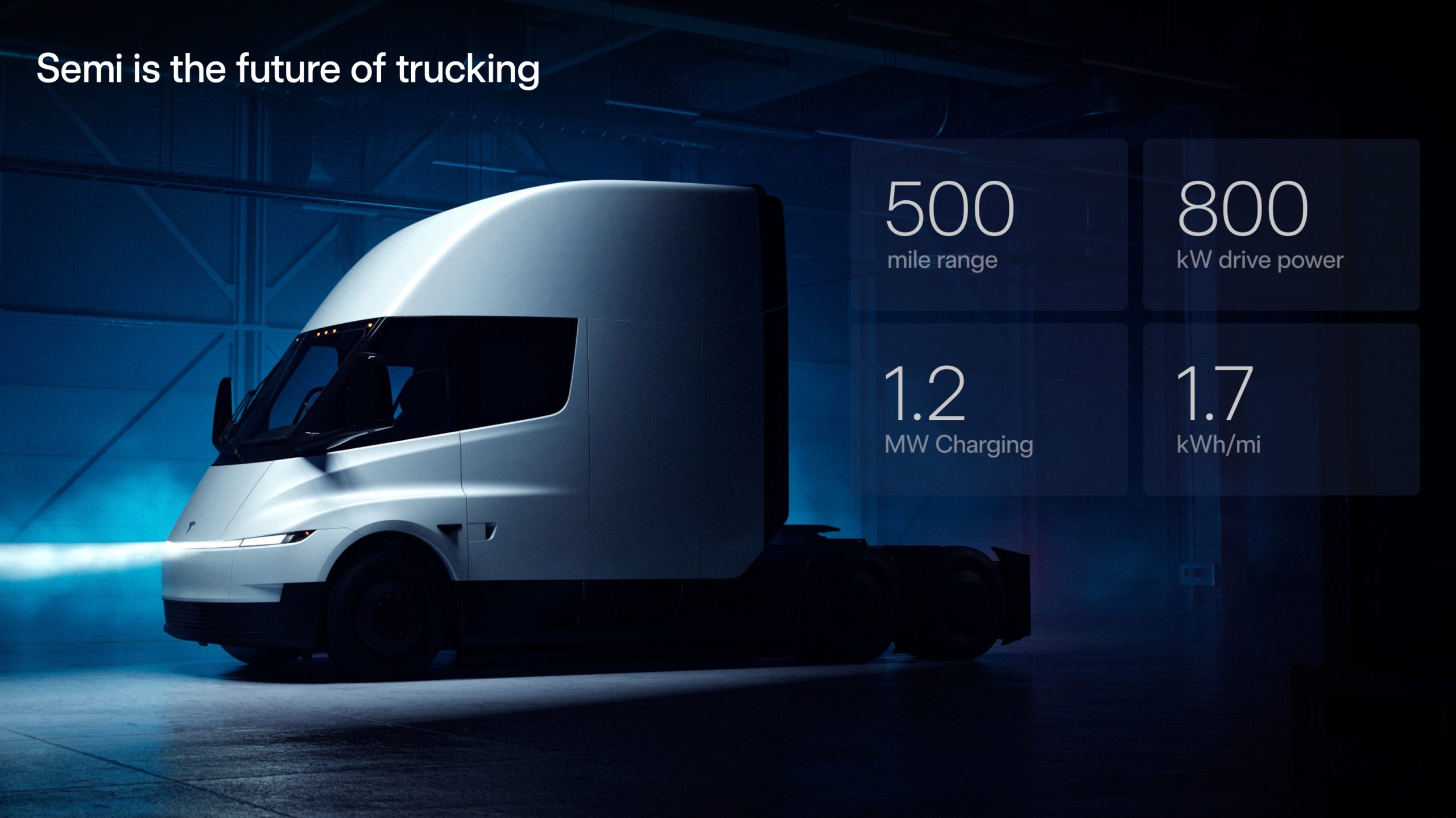News
Tesla Stock Soars 16+% in 1 Day

Tesla’s Model S sedan is red hot.
By Silicon Valley standards, 10-year-old Tesla Motors is middle-aged. But in the world of automotive startups, it’s just crossed a threshold few fledgling companies ever get near: profitability. Late last night California time — in time to make it clear this was no April Fools joke — the company announced it has delivered 4750 cars in the first quarter and expected to report an accounting profit when it announces its official results next month. While the company’s vehicles lack engines, in the past 6 months, it’s begun to hit on all cylinders:
- Shipments of the Model S sedan begin late last year with 2400 delivered in the fourth quarter. The company nearly doubled that in the next 3 months.
- Tesla launched its high-speed “Supercharger” charging stations, which allow recharging half the battery pack in about 30 minutes. Last week, it announced plans to expand the network in the Pacific northwest, Texas, Illinois, and Florida, while improving coverage in the initial regions in the northeast and California.
- The company announced a plan to pay back its Department of Energy loan 5 years ahead of schedule, by the end of 2017. This $465 million loan, part of the Advanced Technology Vehicle Manufacturing Program, was essential to the launch of the Model S and came at a time when Tesla’s future was very much in doubt.
Today, though, that future looks bright enough that the naysayers holding more than 30 million shares short may be wishing they were betting against something else. CEO Elon Musk mentioned on Twitter last week that he had a big announcement to make regarding Tesla (due tomorrow) and clarified last night that this isn’t it: “Also, some may differ, but imo the Tues news is arguably more important,” he wrote. Depending on the nature of that, I may be back with another post.
There was some more interesting news in yesterday’s press release on profitability. The company canceled an option to buy the Model S with the smallest battery, a version that retailed for just around $52,000 after the federal tax credit. Why? Lack of demand. It seems only 4% of buyers were opting for that smallest configuration. They’ll still get it, but instead of producing a battery that small, Tesla will sell them a car with the mid-sized battery and disable part of the capacity in software. If owners — present or future — wish to upgrade to the larger capacity, Tesla will allow them to purchase some software magic to make it happen. The mid-sized battery offers a range of just over 200 miles per the EPA and the smallest battery has about 2/3 the capacity. Given there was a $10,000 gap between the two, it’s noteworthy that people were rejecting the smallest battery so clearly.
This points out the radically different approach Tesla is taking versus Nissan with the Leaf and really everyone else building electric vehicles right now. The two sizes of Tesla people are choosing are 200+ mile vehicle while the other brands are sold as 70-80 mile commuter vehicles. Apparently, a “tweener” that gets around 140 miles wasn’t something Tesla customers wanted and might not be appealing to much of anyone as it doesn’t really address the “go almost anywhere” problem Tesla is solving and doesn’t really do much for commuters. (More than 80% of commutes in the U.S. can be made roundtrip in a Leaf.)
In addition to eliminating the small battery, Tesla also decided to build access to the Supercharger network in every car. It was already standard with the largest battery and is still an option with the smaller one, but now you can decide to add the option after purchase because — again — it’s a software change. The Superchargers are free “fill-ups” along highway corridors, but those with the smaller battery will pay $2000 for the privilege. This software-upgradeable car might not be as much of a milestone as a 200+ mile EV is, but it has already become a hallmark of the way Tesla works and really shows how Silicon Valley DNA can be an important part of this 21st century automaker.
When the company announced its earnings last quarter, the news actually disappointed investors. On some level, that was odd because the quarter inherently represented a transition where production was ramping up and it would be hard to really get a sense of what the business looked like on a steady-state basis. This quarter, however, is going to provide a very real snapshot into Tesla as a business. Through the rest of 2013 and well into next year, the company is likely to look as it does this quarter, with small improvements in unit shipments and gross margin over each quarter until the company begins delivering its Model X crossover late in 2014. None of that is likely exciting to watch, but it is likely to be material financially.
If deliveries do creep into the range of 6000-7000 per quarter — which is expected — and the company hits its gross margin goal of 25% by year end, this quarter’s profit is going to be pretty small compared to the ones set to come. It’s this kind of steady profitable growth upon which you build a company that will be around for a long time to come. And with the focus on larger batteries and more Superchargers, Tesla seems to be saying its cars are going to run long and far as well.

News
Tesla Cybercab tests are going on overdrive with production-ready units
Tesla is ramping its real-world tests of the Cybercab, with multiple sightings of the vehicle being reported across social media this week.

Tesla is ramping its real-world tests of the Cybercab, with multiple sightings of the autonomous two-seater being reported across social media this week. Based on videos of the vehicle that have been shared online, it appears that Cybercab tests are underway across multiple states.
Recent Cybercab sightings
Reports of Cybercab tests have ramped this week, with a vehicle that looked like a production-ready prototype being spotted at Apple’s Visitor Center in California. The vehicle in this sighting was interesting as it was equipped with a steering wheel. The vehicle also featured some changes to the design of its brake lights.
The Cybercab was also filmed testing at the Fremont factory’s test track, which also seemed to involve a vehicle that looked production-ready. This also seemed to be the case for a Cybercab that was spotted in Austin, Texas, which happened to be undergoing real-world tests. Overall, these sightings suggest that Cybercab testing is fully underway, and the vehicle is really moving towards production.
Production design all but finalized?
Recently, a near-production-ready Cybercab was showcased at Tesla’s Santana Row showroom in San Jose. The vehicle was equipped with frameless windows, dual windshield wipers, powered butterfly door struts, an extended front splitter, an updated lightbar, new wheel covers, and a license plate bracket. Interior updates include redesigned dash/door panels, refined seats with center cupholders, updated carpet, and what appeared to be improved legroom.
There seems to be a pretty good chance that the Cybercab’s design has been all but finalized, at least considering Elon Musk’s comments at the 2025 Annual Shareholder Meeting. During the event, Musk confirmed that the vehicle will enter production around April 2026, and its production targets will be quite ambitious.
News
Tesla gets a win in Sweden as union withdraws potentially “illegal” blockade
As per recent reports, the Vision union’s planned anti-Tesla action might have been illegal.

Swedish union Vision has withdrawn its sympathy blockade against Tesla’s planned service center and showroom in Kalmar. As per recent reports, the Vision union’s planned anti-Tesla action might have been illegal.
Vision’s decision to pull the blockade
Vision announced the blockade in early December, stating that it was targeting the administrative handling of Tesla’s facility permits in Kalmar municipality. The sympathy measure was expected to start Monday, but was formally withdrawn via documents sent to the Mediation Institute and Kalmar Municipality last week.
As noted in a Daggers Arbete report, plans for the strike were ultimately pulled after employer group SKR highlighted potential illegality under the Public Employment Act. Vision stressed its continued backing for the Swedish labor model, though Deputy negotiation manager Oskar Pettersson explained that the Vision union and IF Metall made the decision to cancel the planned strike together.
“We will not continue to challenge the regulations,” Petterson said. “The objection was of a technical nature. We made the assessment together with IF Metall that we were not in a position to challenge the legal assessment of whether we could take this particular action against Tesla. Therefore, we chose to revoke the notice itself.”
The SKR’s warning
Petterson also stated that SKR’s technical objection to the Vision union’s planned anti-Tesla strike framed the protest as an unauthorized act. “It was a legal assessment of the situation. Both for us and for IF Metall, it is important to be clear that we stand for the Swedish model. But we should not continue to challenge the regulations and risk getting judgments that lead nowhere in the application of the regulations,” he said.
Vision ultimately canceled its planned blockade against Tesla on December 9. With Vision’s withdrawal, few obstacles remain for Tesla’s long-planned Kalmar site. A foreign electrical firm completed work this fall, and Tesla’s Careers page currently lists a full-time service manager position based there, signaling an imminent opening.
News
Tesla Semi program Director teases major improvements

Tesla Semi Program Director Dan Priestly teased the major improvements to the all-electric Class 8 truck on Thursday night, following the company’s decision to overhaul the design earlier this year.
Priestley said he drove the Semi on Thursday, and the improvements appear to be welcomed by one of the minds behind the project. “Our customers are going to love it,” he concluded.
Just drove the redesigned Semi. Our customers are going to love it. https://t.co/KZ88sf1CDL
— Dan Priestley (@danWpriestley) December 19, 2025
The small detail does not seem like much, but it is coming from someone who has been involved in the development of the truck from A to Z. Priestley has been involved in the Semi program since November 2015 and has slowly worked his way through the ranks, and currently stands as the Director of the program.
Tesla Semi undergoes major redesign as dedicated factory preps for deliveries
Tesla made some major changes to the Semi design as it announced at the 2025 Annual Shareholder Meeting that it changed the look and design to welcome improvements in efficiency.
Initially, Tesla adopted the blade-like light bar for the Semi, similar to the one that is present on the Model Y Premium and the Cybertruck.
Additionally, there are some slight aesthetic changes to help with efficiency, including a redesigned bumper with improved aero channels, a smaller wraparound windshield, and a smoother roofline for better aero performance.
All of these changes came as the company’s Semi Factory, which is located on Gigafactory Nevada’s property, was finishing up construction in preparation for initial production phases, as Tesla is planning to ramp up manufacturing next year. CEO Elon Musk has said the Semi has attracted “ridiculous demand.”
The Semi has already gathered many large companies that have signed up to buy units, including Frito-Lay and PepsiCo., which have been helping Tesla test the vehicle in a pilot program to test range, efficiency, and other important metrics that will be a major selling point.
Tesla will be the Semi’s first user, though, and the truck will help solve some of the company’s logistics needs in the coming years.








